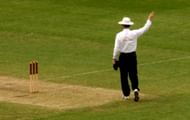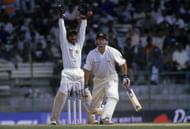Cricket is known for its complicated and long set of rules and laws that make up the game and its various formats. However, just like any sport, its laws established by Marylebone Cricket Club (MCC) ensure fairness and standardisation in the game of cricket. With the game has modernised and is always under scrutiny thanks to various technological advances, the game still has some unknown laws that haven’t been very prevalent in today’s game.Perhaps some of the most avid cricket fans might not know these unknown bylaws that belong in the laws of cricket compiled by the MCC:
#1 Lost ball

If the ball is lost and cannot be recovered the fielding side can call it ‘lost ball’. According to the Law, the delivery then becomes dead and is soon replaced with a ball whose condition was similar to the one that was lost.
The batting side shall be additionally awarded: ‘for any penalties scored, for runs ran between the crease from the batsmen or the amount of runs (maybe even a 6) hit when the ball was lost.’
The runs will be credited to the batsman who hit the ball, if otherwise (on the pads, body) it will be known as extras.
#2 No appeal

Although this might seem like common sense, an umpire is not allowed to give a batsman out without an appeal from the fielding side. According to Law 27, this does not prohibit a batsman from leaving his wicket without an appeal being made.
The umpire shall intervene if a batsman walks and he is satisfied that the batsman is not out. He will call the batsman back onto the field and signal a dead ball. The appeal from the fielding side can be made any time before the bowler starts his run-up for the next delivery.
#3 Mankading

The first incident of this occurred in 1947 when Indian bowler Vinoo Manked dismissed Australian Bill Brown; since then a batsman dismissed in this fashion is known to have been Mankaded. The dismissal occurs when the non-striking batsman backs up too far and leaves his crease before the bowler has gone into his bowling stride and releases the ball.
When mankading occurs successfully, according to the Laws of cricket, it will not count as one ball of the over. If unsuccessful, it will be signalled as a dead ball. If successful it will be seen as a runout and will not go to the bowler as a wicket.
Mankading is more prevalent in indoor cricket; however that does not mean it hasn’t happened in the outdoor game. Recently in 2014, English batsman Jos Buttler was caught out of his crease by Sri Lankan bowler Sachithra Senanayake in an ODI decider in Edgbaston. Senanayake warned the umpire and Buttler in the previous over and when Buttler went out of his crease again, Senanayake dislodged the bails and Buttler was deemed out.
#4 Restriction of injured player

We all know about the restrictions required when a fielder leaves the playing ground. A fielder needs to get permission from the umpire and notify them when they leave the field.
When a player fails to inform the umpire, a penalty of five runs will be awarded to the batting side. However, and this is where it starts to get tricky, if a bowler happens to be longer than 15 minutes off the field, they cannot bowl for the allocated time they were away for. Things get complicated when an innings passes by.
An example of this situation happened in 2007 between India and South Africa, where Sachin Tendulkar was off the field for 18 minutes at the end of the first innings of the Test match. India lost two quick wickets and Tendulkar, who was supposed to come in at number four, couldn’t, because his 18 minutes hadn’t passed.
#5 Handling the ball

This dismissal is only dealt to a batsman who intentionally hits the ball away with his hand and the hand is NOT holding the bat. According to the laws of cricket, there are various ways a batsman can avoid being out via handling the ball – such as when the batsman is trying to avoid injury, or when the batsman is retrieving the ball for the fielder with his consent. The wicket does not go to the bowler.
The last time this incident was given out was in 2001 between India and England, where Michael Vaughan handled a ball from Virender Sehwag in a Test match in Bangalore. Vaughan, who was on 64, hit the ball away from him and was deemed out for handling the ball; only nine instances of this have occurred in International cricket.
#6 Forfeiture

Forfeiture is only applied to the longer format of the game, as it can only occur when each team is scheduled to bat in two innings. This is when a captain can gave up an entire completed innings, in order to get a result in a Test match.
An example of this was in 2000, when South African captain Hansie Cronje approached English captain Nasser Hussain in the fifth and final Test match at Centurion. The rain washed out three days, with South Africa scoring 155 for 6 in the first day.
Cronje chose to declare at 248 in the first innings and forfeited the second innings, with England forfeiting their first and needing 249 to win the test match with less than a day left. England won by two wickets; however controversy struck when it emerged that Cronje was approached by bookmakers, and he had fixed the game so that a result was made.
Follow IPL Auction 2025 Live Updates, News & Biddings at Sportskeeda. Get the fastest updates on Mega-Auction and cricket news
